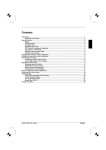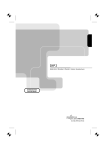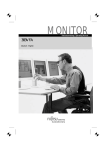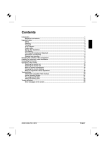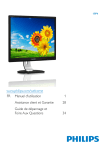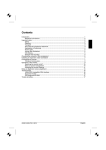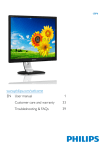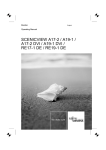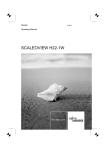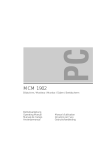Download Siemens MCM 1902 Technical data
Transcript
answers
2
Betriebsanleitung / Operating manual
SCENICVIEW P996-1
Deutsch - English
Downloaded from ManualMonitor.com Manuals
Sie haben ...
... technische Fragen oder Probleme?
Wenden Sie sich bitte an:
●
unsere Hotline:
Mo-Fr: 8 - 18 Uhr
Sa:
9 - 14 Uhr
Tel.: ++ 49 (0) 180 3777 000
●
Ihren zuständigen Vertriebspartner
●
Ihre Verkaufsstelle
Weitere Informationen finden Sie in den Handbüchern "Sicherheit und Ergonomie" und "Garantie".
Aktuelle Informationen zu unseren Produkten, Tipps, Updates usw. finden Sie im Internet:
http://www.fujitsu-siemens.com
Are there ...
... any technical problems or other questions you need clarified?
Please contact:
●
your sales partner
●
your sales outlet
Further information can be found in the "Safety and Ergonomics" and "Warranty" manuals.
The latest information on our products, tips, updates, etc., can be found on the Internet under:
http://www.fujitsu-siemens.com
Downloaded from ManualMonitor.com Manuals
Downloaded from ManualMonitor.com Manuals
Dieses Handbuch wurde auf Recycling-Papier gedruckt.
This manual has been printed on recycled paper.
Ce manuel est imprimé sur du papier recyclé.
Este manual ha sido impreso sobre papel reciclado.
Questo manuale è stato stampato su carta da riciclaggio.
Denna handbok är tryckt på recyclingpapper.
Dit handboek werd op recycling-papier gedrukt.
Herausgegeben von/Published by
Fujitsu Siemens Computers GmbH
Bestell-Nr./Order No.: A26361-K996-Z100-1-5E19
Ausgabe/Edition 1
Printed in Malaysia
AG 0604 06/04
A26361-K967-Z100-1-5E19
Downloaded from ManualMonitor.com Manuals
Deutsch
English
SCENICVIEW P996-1
Farbbildschirm
Colour monitor
Betriebsanleitung
Operating Manual
TCO'99
Ausgabe Juni 2004
June 2004 edition
Downloaded from ManualMonitor.com Manuals
VESA, DDC und DPMS sind eingetragene Warenzeichen der Video Electronics Standards
Association.
Alle Rechte vorbehalten, insbesondere (auch auszugsweise) die der Übersetzung, des
Nachdrucks, der Wiedergabe durch Kopieren oder ähnliche Verfahren.
Zuwiderhandlungen verpflichten zu Schadenersatz.
Alle Rechte vorbehalten, insbesondere für den Fall der Patenterteilung oder GM-Eintragung.
Liefermöglichkeiten und technische Änderungen vorbehalten.
Dieses Handbuch wurde erstellt von
cognitas. Gesellschaft für Technik-Dokumentation mbH
www.cognitas.de
Copyright © Fujitsu Siemens Computers GmbH 2004
VESA, DDC and DPMS are registered trademarks of Video Electronics Standards
Association.
All rights, including rights of translation, reproduction by printing, copying or similar methods,
even of parts are reserved.
Offenders will be liable for damages.
All rights, including rights created by patent grant or registration of a utility model or design,
are reserved.
Delivery subject to availability. Right of technical modification reserved.
This manual was produced by
cognitas. Gesellschaft für Technik-Dokumentation mbH
www.cognitas.de
Downloaded from ManualMonitor.com Manuals
Contents
Introduction........................................................................................................................................1
Notational conventions...............................................................................................................1
Important notes .................................................................................................................................2
Safety notes...............................................................................................................................2
Cleaning ....................................................................................................................................3
Transport ...................................................................................................................................3
X-ray radiation ...........................................................................................................................3
Power cable...............................................................................................................................4
Energy Star Guidelines ..............................................................................................................4
CE marking................................................................................................................................4
FCC Class B Compliance Statement .........................................................................................5
Declaration of Conformity ..........................................................................................................5
Disposal and recycling ...............................................................................................................6
Checking the contents of the consignment ........................................................................................6
Installing an ergonomic video workstation..........................................................................................7
Assembling the monitor base ............................................................................................................8
Connecting the monitor......................................................................................................................8
Operation of the monitor ..................................................................................................................10
Switching the monitor on..........................................................................................................10
Switching the monitor off .........................................................................................................10
Notes on power management ..................................................................................................11
Changing the monitor settings .................................................................................................12
Notes on ergonomic colour adjustment....................................................................................17
Technical data .................................................................................................................................18
VESA-DDC-compatible VGA interface.....................................................................................18
Preset operating modes...........................................................................................................19
Pin assignment D-SUB ............................................................................................................19
Tilting and turning area ............................................................................................................20
Troubleshooting...............................................................................................................................20
Error messages on the screen.................................................................................................21
A26361-K967-Z100-1-5E19, Edition 1
Downloaded
from ManualMonitor.com Manuals
English
Downloaded from ManualMonitor.com Manuals
Introduction
Your new SCENICVIEW P996-1 monitor supplies you with a high-quality colour image with high
resolution and ergonomic refresh rates. It possesses a whole range of useful features and functions,
e.g.:
●
●
19" (46 cm) high-resolution CRT (0.25 mm dot pitch)
automatic scanning of all horizontal frequencies from 30 to 96 kHz and all refresh rates
(vertical frequencies) from 50 to 160 Hz
digital screen controller with microprocessor for storing 16 different display modes
freely adjustable colour alignment for matching the screen colours to the colours of various
input and output devices
convenient operation via integrated OSD (On-Screen-display) menu
VESA-DDC compatibility
power management for reducing power consumption by up to 95 % when the computer system
is not in use
compliance with the latest ergonomic standards (ISO 9241-3)
compliance with the recommendations in accordance with TCO ’99
●
●
●
●
●
●
●
This operating manual contains important information you require to start up and run your monitor.
The monitor interacts closely with the graphics card (screen controller) of your computer. The
monitor processes the data supplied to it by the screen controller. The screen controller/the
associated driver software is responsible for setting the modes (resolution and refresh rate).
Target group
You don't need to be an "expert" to perform the operations described here. Do, however, read the
"Important notes" chapter in the operating manual of the computer and in this operating manual.
In the event of any problems occurring, please contact your sales outlet or our help desk.
Additional information
Details of how you set the resolution and refresh rate are provided in the documentation on your
screen controller/the associated driver software.
Notational conventions
The meanings of the symbols and fonts used in this manual are as follows:
►
!
Pay particular attention to text marked with this symbol. Failure to observe this warning
endangers your life, destroys the device, or may lead to loss of data.
i
Supplementary information, remarks, and tips follow this symbol.
Text which follows this symbol describes activities that must be performed in the order shown.
"Quotation marks" indicate names of chapters or terms.
A26361-K967-Z100-1-5E19, Edition 1
Downloaded
from ManualMonitor.com Manuals
English - 1
Colour Monitor SCENICVIEW P996-1
Important notes
!
In this chapter you will find information regarding safety which is essential to take note of
with your monitor.
Safety notes
This device complies with the relevant safety regulations for data processing equipment, including
electronic office machines for use in an office environment. If you have any questions, contact your
sales outlet or our help desk.
●
If the device is brought into the installation site from a cold environment, condensation can
form. Before operating the device, wait until it is absolutely dry and has reached approximately
the same temperature as the installation site.
●
During installation and before operating the device, please observe the instructions on
environmental conditions in the "Technical data" chapter as well as the instructions in the
"Installing an ergonomic video workstation" chapter.
●
To ensure adequate ventilation the monitor may only be operated with the monitor foot
installed.
●
The colour monitor must not be exposed to strong magnetic fields (e.g. caused by magnetic
paper clip holders or loudspeakers). Strong magnetic fields could result in a permanent blotchy
image.
●
The monitor is automatically degaussed when switched on. This results in a magnetic field
around the metal edge of the picture tube, which may damage the data on data carriers
nearby. Therefore, never keep magnetic data carriers near the monitor.
●
The device automatically sets itself to the correct voltage within the range from 220 V to 240 V.
Ensure that the local mains voltage lies within these limits.
●
The device must be installed in such a way that the user has good access to the appliance
socket.
●
The ON/OFF switch does not disconnect the device from the mains voltage. To completely
disconnect the mains voltage, remove the power plug from the socket.
●
Lay all cables so that nobody can stand on them or trip over them. When attaching the device,
observe the relevant notes in the "Connecting the monitor" chapter.
●
No data transfer cables should be connected or disconnected during a thunderstorm.
●
Please ensure that no objects (e.g. necklaces, paperclips etc.) or liquids can get into the
interior of the device (this may cause an electrical shock or short circuit).
●
In emergencies (e.g. damaged casing, elements or cables, penetration of liquids or foreign
matter), switch off the unit, disconnect the power plug and contact your sales outlet or our help
desk.
●
Only qualified technicians should repair the device. Unauthorised opening and incorrect repair
may greatly endanger the user (electric shock, fire risk).
2 - English
Downloaded from ManualMonitor.com Manuals
A26361-K967-Z100-1-5E19, Edition 1
Colour Monitor SCENICVIEW P996-1
●
Tampering with the device, in particular adjusting the high voltage or installing a different type
of CRT tube, may result in a large amount of X-ray radiation being emitted. Devices modified
in this way no longer comply with their licence and may not be used.
●
You may set only those resolutions and refresh rates specified in the "Technical data" chapter.
Otherwise you may damage your monitor. If you are in any doubt, contact your sales outlet or
our help desk.
●
Use a screen saver with moving images and activate the power management for your monitor
to prevent still images from "burning in".
●
Keep this operating manual together with your device. If you pass on the device to third
parties, you should include this manual.
Cleaning
●
Always pull out the power plug before you clean the monitor.
●
Do not clean any interior parts yourself, leave this job to a service technician.
●
Do not use any cleaning agents that contain abrasives or may corrode plastic.
●
Ensure that no liquid will run into the system.
●
Ensure that the ventilation areas of the monitor are free.
●
When cleaning the surface of the screen, always use a soft, slightly damp cloth in order to
avoid scratching the glass.
Wipe the monitor casing with a dry cloth. If the monitor is particularly dirty, use a cloth which has
been moistened in mild domestic detergent and then carefully wrung out.
Transport
●
When transporting the monitor ensure that it is not exposed to strong magnetic fields.
●
Transport the monitor with care and only in its original packaging or another corresponding
packaging fit to protect it against knocks and jolts.
●
Above all, never drop the monitor. If the CRT is damaged, there is a risk of implosion!
X-ray radiation
This device complies with the German X-ray regulations (Röntgenverordnung - RöV). The local
dosage emitted is less than 1 µSv/h (micro-Sievert per hour) at a distance of 0.1m.
A26361-K967-Z100-1-5E19, Edition 1
Downloaded
from ManualMonitor.com Manuals
English - 3
Colour Monitor SCENICVIEW P996-1
Power cable
To guarantee safe operation, use the cable supplied. Use the following guidelines if it is necessary
to replace the original cable set.
●
The female/male receptacles of the cord set must meet CEE-22 requirements.
●
The cable has to be HAR-certified or VDE-certified. The mark HAR or VDE will appear on the
outer sheath or on the insulation of one of the inner conductors.
●
For devices which are mounted on a desk or table, type SVT or SJT cable sets may be used.
For devices which sit on the floor, only SJT type cable sets may be used.
●
The cable set must be selected according to the rated current for your device.
Energy Star Guidelines
The Fujitsu Siemens colour monitor SCENICVIEW P996-1 is designed to
conserve electricity by dropping to less than 1 W when it goes OFF mode.
With this new power management the SCENICVIEW P996-1 qualifies for
the U.S. Environmental Protection Agency's (EPA) Energy Star
Computers award.
The EPA estimates that computer equipment uses 5 % percent of all business electricity and that
this is growing rapidly. If all desktop computers and peripherals enter a low-power mode when not in
use, the overall savings in electricity could amount to $ 2 thousand million annually. These savings
could also prevent the emission of 20 million tons of carbon dioxide into the atmosphere - the
equivalent of 5 million automobiles.
As an Energy Star Partner, Fujitsu Siemens Computers GmbH has determined that this product
meets the Energy Star guidelines for energy efficiency.
CE marking
The shipped version of this device complies with the requirements of the EEC
directives 89/336/EEC "Electromagnetic compatibility" and 73/23/EEC "Low voltage
directive".
4 - English
Downloaded from ManualMonitor.com Manuals
A26361-K967-Z100-1-5E19, Edition 1
Colour Monitor SCENICVIEW P996-1
FCC Class B Compliance Statement
The following statement applies to the products covered in this manual, unless otherwise specified
herein. The statement for other products will appear in the accompanying documentation.
NOTE:
This equipment has been tested and found to comply with the limits for a "Class B" digital device,
pursuant to Part 15 of the FCC rules and meets all requirements of the Canadian InterferenceCausing Equipment Regulations. These limits are designed to provide reasonable protection against
harmful interference in a residential installation. This equipment generates, uses and can radiate
radio frequency energy and, if not installed and used in strict accordance with the instructions, may
cause harmful interference to radio communications. However, there is no guarantee that
interference will not occur in a particular installation. If this equipment does cause harmful
interference to radio or television reception, which can be determined by turning the equipment off
and on, the user is encouraged to try to correct the interference by one or more of the following
measures:
●
●
●
●
Reorient or relocate the receiving antenna.
Increase the separation between equipment and the receiver.
Connect the equipment into an outlet on a circuit different from that to which the receiver is
connected.
Consult the dealer or an experienced radio/TV technician for help.
Fujitsu Siemens Computers GmbH is not responsible for any radio or television interference caused
by unauthorised modifications of this equipment or the substitution or attachment of connecting
cables and equipment other than those specified by Fujitsu Siemens Computers GmbH. The
correction of interference caused by such unauthorised modification, substitution or attachment will
be the responsibility of the user.
The use of shielded I/O cables is required when connecting this equipment to any and all optional
peripheral or host devices. Failure to do so may violate FCC rules.
Declaration of Conformity
This device complies with Part 15 of the FCC Rules. Operation is subject to the following two
conditions: (1) this device may not cause harmful interference, and (2) this device must accept any
interference received, including interference that may cause undesired operation.
Product name:
Trade name:
Model number(s):
Name of responsible party:
Contact person:
Phone No.:
Fax No.:
Colour CRT Monitor
Fujitsu Siemens Computers Inc.
SCENICVIEW P996-1
Siemens Information and Communication
Products LLC
3860 N. First Street
San Jose, CA 95134-1702
U.S.A.
Schroettle-Henning, Bernd
(408) 571-6051
(408) 571-6196
We, Siemens Information and Communication Products LLC, hereby declare that the equipment
bearing the trade name and model number specified above was tested confirming to the applicable
FCC Rules under the most accurate measurement standards possible, and that all the necessary
steps have been taken and are in force to assure that production units of the same equipment will
continue to comply with the Commissions requirements.
A26361-K967-Z100-1-5E19, Edition 1
Downloaded
from ManualMonitor.com Manuals
English - 5
Colour Monitor SCENICVIEW P996-1
Disposal and recycling
This device has been manufactured to the highest possible degree from materials which can be
recycled or disposed of in a manner that is not environmentally damaging. The CRT contains no
cadmium
The device may be taken back after use to be recycled, provided that it is returned in a condition
that is the result of normal use. Any components not reclaimed will be disposed of in an
environmentally acceptable manner.
We herewith declare that it will be possible to repair any device marked
with the eco-label for at least 5 years after production of that device has
discontinued.
If you have any questions on disposal, please contact your local office, our help desk, or:
Fujitsu Siemens Computers GmbH
Recyclingcenter
D-33106 Paderborn
Tel.: ++ 49 5251 - 818 010/ Fax: ++ 49 5251 - 818 015
Checking the contents of the consignment
►
Unpack all the individual parts.
►
Remove any plastic caps from the plugs for the cables in the consignment.
►
Check the delivery for damage incurred during transportation.
►
Check whether the delivery agrees with the details in the delivery note.
The complete shipment comprises:
–
one monitor with data cable
–
one power cable
–
one monitor base
–
one Warranty Booklet
–
this operating manual
Should you discover that the delivery does not correspond to the delivery note, notify your local
sales outlet immediately.
i
It is recommended not to throw away the original packaging material. Keep it for future
transportation.
6 - English
Downloaded from ManualMonitor.com Manuals
A26361-K967-Z100-1-5E19, Edition 1
Colour Monitor SCENICVIEW P996-1
Installing an ergonomic video workstation
Before you set up your equipment, you should select a suitable position for working at the monitor.
Please observe the following advice when installing a video workstation.
1
1
1 = Windows
Avoid direct and reflected glare.
Avoid glare from electric
lighting.
600 mm
600 mm
2
2
1 = Edge of desk
2 = Permissible reaching
sector
Position the keyboard where it
is easiest to reach.
1
0°
2
65°
30°
60°
30°
65°
2
1
2
1 = Preferable viewing sector
2 = Permissible viewing sector
Keep ventilated areas clear.
Position the monitor for
optimum viewing. The viewing
distance to the monitor should
be approximately 50 cm.
A26361-K967-Z100-1-5E19, Edition 1
Downloaded
from ManualMonitor.com Manuals
1 = approx. 90° and more
2 = approx. 90°
Remember to maintain correct
posture.
English - 7
Colour Monitor SCENICVIEW P996-1
Assembling the monitor base
Your monitor is shipped with a base which allows you to rotate and tilt the monitor to the best
position.
Attach the base as follows:
!
►
Lay the monitor with the display downwards
on a soft surface.
►
Fit the base so that its hooks slot into the
recesses on the monitor.
►
Slide the base forward in the direction of
the arrow until it clicks into position.
►
Place the monitor in an upright position.
To ensure adequate ventilation the monitor may only be operated with the monitor foot
installed.
Connecting the monitor
Information on the computer connections is contained in the operating manual for your computer.
!
Observe the safety precautions in the "Important notes" chapter in this operating manual.
Do not cover the ventilation openings of the monitor.
If you are assembling monitors beside each other, there must be a minimum distance of
30 cm between monitors of the same constructional type, to avoid image distortion. With
different monitors, the distance must be increased, if necessary.
8 - English
Downloaded from ManualMonitor.com Manuals
A26361-K967-Z100-1-5E19, Edition 1
Colour Monitor SCENICVIEW P996-1
►
Be sure that the monitor and the computer are switched off.
1 = Power connector
2 = Data cable
!
The computer power plug must be pulled out!
The data cable is permanently attached to the monitor. It has a 15-pin D-SUB connector for the
monitor port of the computer.
►
Connect the 15-pin connector of the data cable to the (active) monitor port on the computer
and secure the plug-in connection by tightening the safety screws.
i
If your computer has two monitor ports ("onboard" screen controller and separate
graphics card), the monitor port for the separate graphics card is usually active.
►
Plug the power cable supplied into the power connector of the monitor.
►
Plug the power cable into the monitor connector at the rear of the computer.
►
Plug the power connector of the computer into a properly grounded mains outlet.
i
When you start working with your monitor for the first time you should install the
appropriate graphics drivers for your application software. Details of how to do this are
provided in the documentation on your graphics card/the associated driver software.
A26361-K967-Z100-1-5E19, Edition 1
Downloaded
from ManualMonitor.com Manuals
English - 9
Colour Monitor SCENICVIEW P996-1
Operation of the monitor
1 = Buttons for the OSD menu
(On-Screen-display)
2 = Power indicator
3 = ON/OFF switch
Switching the monitor on
►
Drücken Sie den Ein-/Ausschalter (3).
The power indicator (2) lights up green when the computer is switched on.
i
If your computer has a power management function (energy-saving mode), you should
read the "Notes on power management" of the monitor in this chapter.
When you start your system, several mode changes will usually be carried out when
various programmes are called automatically (different settings for resolution and image
refresh rate). Do not be confused by the unusual displays. They are not error messages.
Switching the monitor off
►
Drücken Sie den Ein-/Ausschalter (3).
The power indicator (2) is dark.
10 - English
Downloaded from ManualMonitor.com Manuals
A26361-K967-Z100-1-5E19, Edition 1
Colour Monitor SCENICVIEW P996-1
Notes on power management
If your computer is equipped with power management, the monitor can support this function fully.
Here the monitor does not distinguish between the individual energy-saving modes of the computer
(standby mode, suspend mode and OFF mode), as it is capable of immediately switching into the
mode with the highest energy-saving effect.
Stage
ON
Energy-saving mode
Power indicator
lights green
flashes green
Function
the monitor is working
normally
the screen is dark
Power consumption
normal w 90 W
reduced to q 2 W
If your computer detects inactivity (no input) it sends an appropriate signal to the monitor to reduce
the power consumption. The power indicator of the monitor changes colour to indicate the status
change.
If there is still no input, power consumption is further reduced (OFF mode).
Once an input is made at the computer the screen contents are redrawn and full power is restored.
The length of the individual stages is determined by the power management system of the
computer. For detailed information on how energy-saving mode operates refer to the operating
manual or technical manual of the computer.
i
The service life of your monitor will be extended if the OFF mode is switched to after
30 minutes at the earliest (setting in screen saver or in your computer's BIOS setup).
When the monitor is switched to OFF mode by the power management system a power
consumption of up to 2 W is maintained to feed the circuit for redrawing the screen
contents.
A26361-K967-Z100-1-5E19, Edition 1
Downloaded
from ManualMonitor.com Manuals
English - 11
Colour Monitor SCENICVIEW P996-1
Changing the monitor settings
The monitor display is adjusted with the buttons of the control panel.
Menu
Exit
1
1 = Exit button
3
2
2 = Arrow buttons
4
3 = Menu button
4 = ON/OFF switch
Menu button
The menu button switches on the OSD menu and activates the selected function.
65
When the menu is activated, mark the symbol for the topic or function you want to
set with the buttons 6 and 5.
When the menu is not activated, these buttons have not function.
34
Exit button
When the menu is activated, set the values for the selected function with the
buttons 3 and 4.
When the menu is not activated, you can display the setting window for brightness
and contrast directly with the buttons 3 and 4.
The Exit button deactivates the OSD menu or returns you from a submenu to its
superior menu.
Setting functions with OSD menu
To make a setting for a function, perform the following steps:
►
Press the Menu button to activate the OSD menu.
The OSD menu is displayed on the screen.
On the left-hand side of the OSD menu the symbols for the individual topics
are displayed. On the right-hand side of the OSD menu the respective
functions are displayed which belong to the individual topics.
►
►
Select the symbol for the topic that contains the desired function with the buttons 6 or 5.
Press the Menu button to select the marked topic.
12 - English
Downloaded from ManualMonitor.com Manuals
A26361-K967-Z100-1-5E19, Edition 1
Colour Monitor SCENICVIEW P996-1
The functions of the selected topic are shown on the right in the OSD menu.
►
►
Mark the function for which you want to change the settings with the buttons 6 or 5.
Press the Menu button to select the highlighted function.
You can now change the value of the selected function.
►
►
Set the value of the selected function with the buttons 3 and 4.
Press the Exit button to exit the function again.
The set value is applied.
►
Mark the next function for which you want to change the setting with the buttons 6 or 5. To
select a different topic, press the Exit button. Change the setting of the desired function as
described above.
All modifications are automatically stored if no button is pressed for several seconds. The OSD
menu disappears after approx. 15 seconds.
►
To exit the OSD menu immediately, press the Exit button again.
All setting options for the individual functions are described in the following.
The menus
This menu contains the following functions:
●
Adjusting the brightness
●
Adjusting the contrast
●
Set or deactivate moiré reduction
●
Degaussing the screen
●
Activating the factory settings
Adjusting the contrast
With this function you set the contrast between the foreground and the background of the
picture.
i
You will increase the life of your screen if you adjust the contrast and brightness to
medium.
Adjusting the brightness
With this function you set the brightness of the picture.
A26361-K967-Z100-1-5E19, Edition 1
Downloaded
from ManualMonitor.com Manuals
English - 13
Colour Monitor SCENICVIEW P996-1
Set or deactivate moiré reduction
With this function you set the effectiveness of the horizontal and vertical Moiré reduction.
To deactivate the moiré reduction, set the value to 0.
If the picture you see on screen has light and dark stripes or appears dull and blurred, this
may be due to what is known as the moiré effect. This effect usually has physical causes,
being triggered by interference between the pixels in the matrix and the video signal. The
intensity of the moiré effect is dependent on the screen resolution and horizontal frequency.
Set the picture size, brightness, etc. before you switch on moiré reduction.
i
Only switch moiré reduction on if you can see light and dark stripes on your screen,
or if the picture is dull and blurred.
In some cases, moiré reduction may cause the picture quality to deteriorate
(reduced picture definition, slight flickering).
Degaussing the screen
When colour shifts occur in the screen display due to the influence of magnetic fields (e.g.
after transporting or turning the screen), the screen must be degaussed.
Do not use the feature more than once within a 15-minute period.
Activating the factory settings
There are factory settings for the picture position, picture size, pincushion, trapezoidal and
parallelogram distortion, as well as moiré reduction in the default operating modes.
Select the option "Activate factory settings" (=Yes) with the button 4 .
Select the option "Cancel function'" (=NO) with the button 3.
i
14 - English
When you activate the factory settings, the functions named above are reset to the
factory settings. All other settings remain unchanged.
Downloaded from ManualMonitor.com Manuals
A26361-K967-Z100-1-5E19, Edition 1
Colour Monitor SCENICVIEW P996-1
This menu contains the following functions:
●
Setting the colour temperature
●
Setting colour ratios
●
Setting the sRGB colour mode
Setting the colour temperature
The "warmth" of the screen colours is set using the colour temperature.
You can set the colour temperature in the range from 6500 K to 9300 K in 100 K steps. The
current colour temperature is shown in the menu.
Setting colour ratios
With these functions you set the colour ratio for the respectively selected colour.
Setting the sRGB colour mode
With this function you switch the colour display of the monitor according to the sRGB
standard on or off.
With the button 4 you switch the sRGB colour mode on (=ON).
With the button 3 you switch the sRGB colour mode off (=OFF).
This menu contains the following functions:
●
Adjusting the horizontal position
●
Adjusting the vertical position
●
Adjusting the horizontal size
●
Adjusting the vertical size
●
Correcting pincushion distortion
●
Correcting trapezoid distortion
●
Correcting parallelogram distortion
A26361-K967-Z100-1-5E19, Edition 1
Downloaded
from ManualMonitor.com Manuals
English - 15
Colour Monitor SCENICVIEW P996-1
Adjusting the horizontal position
With this function you move the picture to the left or to the right.
Adjusting the vertical position
With this function you move the picture up or down.
Adjusting the horizontal size
With this function you narrow or widen the screen display.
Adjusting the vertical size
With this function you compress or stretch the screen display.
Correcting pincushion distortion
Pincushion distortion is when the sides of the screen displays are bent inward or outward.
With this function you bend the sides of the screen display inward or outward.
Correcting unsymmetrical pincushion distortion
Unsymmetrical pin balance is when the sides of the screen displays are bent inward or
outward on one side.
With this function you set the sides of the screen display symmetrically.
Correcting trapezoid distortion
Trapezoid distortion is when the top or bottom of the screen display is too wide or too narrow.
With this function you have the following options:
●
You compress the lower edges and stretch the upper edges of the screen display.
●
You compress the upper edges and stretch the lower edges of the screen display.
Correcting parallelogram distortion
Parallelogram distortion means that the sides of the picture bend to the left or right.
With this function you reduce the slope of the right or left side of the screen display.
Correcting rotation
With this function you rotate the screen display clockwise or anti-clockwise.
Correct corner distortion (top)
With this function you correct the upper edges of the screen display.
Correct corner distortion (bottom)
With this function you correct the lower edges of the screen display.
16 - English
Downloaded from ManualMonitor.com Manuals
A26361-K967-Z100-1-5E19, Edition 1
Colour Monitor SCENICVIEW P996-1
In the first line of this view you see the set horizontal frequency and
the refresh rate of the monitor.
In the second line you see the set screen resolution. If none of the
default operating modes is set, for example "PP" is shown instead
of the screen resolution.
An overview of the default operating modes is provided in the
section "Preset operating modes".
Notes on ergonomic colour adjustment
If you select colours for the display in your application programmes, take note of the information
below.
The primary colours blue and red on a dark background do not produce the minimum required
contrast of 3:1 and are therefore not suitable for continuous text and data entry.
When using several colours for characters and background and giving the primary colours full
modulation, you can obtain very suitable colour combinations (see the following table):
Background
Characters
black
black
white
purple
blue
cyan
green
yellow
red
+
+
–
+
+
+
–
+
+
–
–
–
+
–
–
–
–
–
+
–
+
–
white
+
purple
+
+
blue
–
+
–
cyan
+
–
–
+
green
+
–
–
+
–
–
yellow
+
–
+
+
–
–
red
–
+
–
–
–
–
–
–
–
–
+
+
+
Colour combination very suitable; light background colours are only suitable for devices which
are operated with a refresh rate of at least 75 Hz.
–
Colour combination not suitable because colour locations are too close together, thin
characters are not identifiable or rigorous focusing is demanded of the human eye.
A26361-K967-Z100-1-5E19, Edition 1
Downloaded
from ManualMonitor.com Manuals
English - 17
Colour Monitor SCENICVIEW P996-1
Technical data
Dimensions and weight
CRT:
48 cm (19”)
Visible diagonals:
46 cm
Dot pitch:
0.25 mm
Maximal resolution:
1600 x 1200 pixels
Dimensions (W x H x D):
440 mm x 455 mm x 459 mm
Weight:
21.6 kg
Accessories:
Power cable (1.8 m)
Storable display modes:
16 (8 of which are preset)
Electrical data
Video:
analogue, positive, 0.7 Vpp, 75 Ω
Synchronisation:
TTL
Horizontal frequency:
30 kHz .... 96 kHz (multi-scanning)
Refresh rate:
50 Hz .... 160 Hz
Maximum pixel rate:
205 MHz
Power supply:
100 V - 240 V ±10%, 60 Hz /50 Hz ±3 Hz, q 2 A
Power consumption (see power
management):
w 90 W (ON, Normal mode)
q 2 W (OFF mode)
Environmental conditions
Environment class 3K2, IEC 721
Rated range of operation:
Humidity:
10 °C .... 40 °C
10 % .... 80 %
Limit range of operation:
Humidity:
0 °C .... 60 °C
5 % .... 90 %
Condensation must be avoided.
VESA-DDC-compatible VGA interface
Your monitor is equipped with a VESA-DDC-compatible VGA interface. VESA-DDC (Video
Electronics Standard Association, Display Data Channel) is used as the communications interface
between the monitor and the computer. If your computer is equipped with a VESA-DDC-compatible
VGA interface, it can automatically read the data for ensuring optimum operation from your monitor
and select the appropriate settings.
i
If the monitor SCENICVIEW P996-1 is not yet displayed in the list of monitors, you can
select one of the following monitors instead:
Fujitsu Siemens, Siemens or Siemens Nixdorf 19P4, 19P2, 19P1, MCM 1902, 17P3,
17P2, X178, MCM 1707, MCM 1705
18 - English
Downloaded from ManualMonitor.com Manuals
A26361-K967-Z100-1-5E19, Edition 1
Colour Monitor SCENICVIEW P996-1
Preset operating modes
The picture position and size have been set to optimum values at the factory for the
operating modes listed above. Depending on the screen controller used, it may be
necessary to adjust the display position and size. In this case, you can change and save
the settings (see "Changing the monitor settings").
i
Horizontal frequency
Refresh rate
Screen resolution
31,5 kHz +1 kHz
31,5 kHz +1 kHz
43,3 kHz +1 kHz
53,7 kHz +1 kHz
68,7 kHz +1 kHz
80,0 kHz +1 kHz
91,2 kHz +1 kHz
93,7 kHz +1 kHz
60 Hz +2 Hz
70 Hz +2 Hz
85 Hz +2 Hz
85 Hz +2 Hz
85 Hz +2 Hz
75 Hz +2 Hz
85 Hz +2 Hz
75 Hz +2 Hz
640 x 480
720 x 400
640 x 480
800 x 600
1024 x 768
1280 x 1024
1280 x 1024
1600 x 1200
For ergonomic reasons we recommend a refresh rate of at least 85 Hz and a maximum resolution of
1280 x 1024 pixels.
Pin assignment D-SUB
5
1
6
10
15
11
Pin
Meaning
Pin
Meaning
1
Video input red
9
+5 V for DDC
2
Video input green
10
Logic ground
3
Video input blue
11
Ground
4
Ground
12
DDC data (SDA)
5
DDC Return
13
H. sync
6
Red video earth
14
V. sync
7
Green video earth
15
DDC Clock
8
Blue video earth
A26361-K967-Z100-1-5E19, Edition 1
Downloaded
from ManualMonitor.com Manuals
(SCL)
English - 19
Colour Monitor SCENICVIEW P996-1
Tilting and turning area
13°
45°
45°
5°
The specified tilting area refers to the zero position of the monitor foot marked with an arrow.
Troubleshooting
Should an error occur, first check the following points. If the distortion is still not eliminated, the
monitor should, if possible, be checked on another computer.
If you are unable to solve the problem, please inform our help desk.
The display is too small or not centred
The monitor recognises an undefined mode.
►
Adjust the picture size, position and edges (see "Operation of the monitor").
Colour displacements
►
Degauss the monitor (see "Operation of the monitor").
►
Ensure that there are no devices or objects near the monitor which generate magnetic fields
(e.g. loudspeakers, plug-in power supply units).
Flickering picture
►
Set an ergonomic refresh rate (> 75 Hz) using the computer software (see documentation for
your computer or your graphics card).
►
Ensure that the monitor is kept at a distance of at least 30 cm from other monitors of the same
construction type. With different monitors, the distance must be increased, if necessary.
20 - English
Downloaded from ManualMonitor.com Manuals
A26361-K967-Z100-1-5E19, Edition 1
Colour Monitor SCENICVIEW P996-1
No display (power indicator does not light)
►
Check whether the monitor is switched on.
►
Check whether the power cable on the monitor is connected correctly.
►
Check whether the computer is switched on.
No display (power indicator lights)
►
Check whether the computer is switched on.
►
Check whether the data cable for the monitor is correctly attached to the monitor port on the
computer.
►
Check whether the monitor connection of the computer used is active.
►
Press any key on the computer keyboard - the computer may be in energy saving mode.
►
Change the brightness and/or the contrast; the monitor may be adjusted to the maximum dark
setting.
Error messages on the screen
The input signal (horizontal frequency and refresh rate) does not correspond to the technical
monitor data.
►
Adjust the video frequency range using the computer software (see documentation for your
computer or your graphics card).
The monitor does not recognise an input signal.
►
Check whether the computer is switched on.
►
Check whether the power cable on the computer is connected to a mains outlet with earthing
contact.
A26361-K967-Z100-1-5E19, Edition 1
Downloaded
from ManualMonitor.com Manuals
English - 21
TCO'99
Congratulations
You have just purchased a TCO'99 approved and labelled product!
Your choice has provided you with a product developed for
professional use. Your purchase has also contributed to reducing
the burden on the environment and also to the further development
of environmentally adapted electronics products.
Why do we have environmentally labelled computers?
In many countries, environmental labelling has become an established method for encouraging the
adaptation of goods and services to the environment. The main problem, as far as computers and
other electronics equipment are concerned, is that environmentally harmful substances are used
both in the products and during their manufacture. Since it is not so far possible to satisfactorily
recycle the majority of electronics equipment, most of these potentially damaging substances
sooner or later enter nature.
There are also other characteristics of a computer, such as energy consumption levels, that are
important from the viewpoints of both the work (internal) and natural (external) environments. Since
all methods of electricity generation have a negative effect on the environment (e.g. acidic and
climate-influencing emissions, radioactive waste), it is vital to save energy. Electronics equipment in
offices is often left running continuously and thereby consumes a lot of energy.
What does labelling involve?
This product meets the requirements for the TCO'99 scheme which provides for international and
environmental labelling of personal computers. The labelling scheme was developed as a joint effort
by the TCO (The Swedish Confederation of Professional Employees), Svenska
Naturskyddsforeningen (The Swedish Society for Nature Conservation) and Statens
Energimyndighet (The Swedish National Energy Administration).
Approval requirements cover a wide range of issues: environment, ergonomics, usability, emission
of electric and magnetic fields, energy consumption and electrical and fire safety.
The environmental demands impose restrictions on the presence and use of heavy metals,
brominated and chlorinated flame retardants, CFCs (freons) and chlorinated solvents, among other
things. The product must be prepared for recycling and the manufacturer is obliged to have an
environmental policy which must be adhered to in each country where the company implements its
operational policy.
The energy requirements include a demand that the computer and/or display, after a certain period
of inactivity, shall reduce its power consumption to a lower level in one or more stages. The length
of time to reactivate the computer shall be reasonable for the user.
Labelled products must meet strict environmental demands, for example, in respect of the reduction
of electric and magnetic fields, physical and visual ergonomics and good usability.
Downloaded from ManualMonitor.com Manuals
TCO'99 - 1
TCO'99
Below you will find a brief summary of the environmental requirements met by this product. The
complete environmental criteria document may be ordered from:
TCO Development
SE-114 94 Stockholm, Sweden
Fax: +46 8 782 92 07
Email (Internet): [email protected]
Current information regarding TCO'99 approved and labelled products may also be obtained via the
Internet, using the address: http://www.tco-info.com/
Environmental requirements
Flame retardants
Flame retardants are present in printed circuit boards, cables, wires, casings and housings. Their
purpose is to prevent, or at least to delay the spread of fire. Up to 30% of the plastic in a computer
casing can consist of flame retardant substances. Most flame retardants contain bromine or
chloride, and those flame retardants are chemically related to another group of environmental toxins,
PCBs. Both the flame retardants containing bromine or chloride and the PCBs are suspected of
giving rise to severe health effects, including reproductive damage in fish-eating birds and
mammals, due to the bio-accumulative 1) processes. Flame retardants have been found in human
blood and researchers fear that disturbances in foetus development may occur.
The relevant TCO'99 demand requires that plastic components weighing more than 25 grams must
not contain flame retardants with organically bound bromine or chlorine. Flame retardants are
allowed in the printed circuit boards since no substitutes are available.
Cadmium 2)
Cadmium is present in rechargeable batteries and in the colour-generating layers of certain
computer displays. Cadmium damages the nervous system and is toxic in high doses. The relevant
TCO'99 requirement states that batteries, the colour-generating layers of display screens and the
electrical or electronics components must not contain any cadmium.
Mercury 2)
Mercury is sometimes found in batteries, relays and switches. It damages the nervous system and
is toxic in high doses. The relevant TCO'99 requirement states that batteries may not contain any
mercury. It also demands that mercury is not present in any of the electrical or electronics
components associated with the labelled unit. There is however one exception. Mercury is, for the
time being, permitted in the back light system of flat panel monitors as there today is no
commercially available alternative. TCO aims on removing this exception when a mercury free
alternative is available.
CFCs (freons)
The relevant TCO'99 requirement states that neither CFCs nor HCFCs may be used during the
manufacture and assembly of the product. CFCs (freons) are sometimes used for washing printed
circuit boards. CFCs break down ozone and thereby damage the ozone layer in the stratosphere,
causing increased reception on earth of ultraviolet light with e.g. increased risks of skin cancer
(malignant melanoma) as a consequence.
Lead 2)
Lead can be found in picture tubes, display screens, solders and capacitors. Lead damages the
nervous system and in higher doses, causes lead poisoning. The relevant TCO´99 requirement
permits the inclusion of lead since no replacement has yet been developed.
1) Bio-accumulative is defined as substances which accumulate within living organisms.
2) Lead, Cadmium and Mercury are heavy metals which are Bio-accumulative.
2 - TCO'99
Downloaded from ManualMonitor.com Manuals































